Diet will have a direct effect on egg quality, fertility ratio, number of larvae
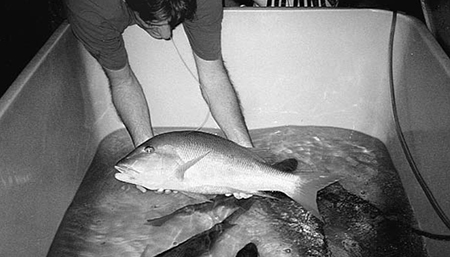
Broodstock management is critical for a viable marine finfish aquaculture project. Maintaining a healthy group of adult fish acclimated in a captive setting provides viable eggs through spawnings year-round.
Prophylactics and quarantine are mandatory steps prior to maturation, spawning, larval rearing, and fingerling production in any marine fish hatchery.
Capture and transportation
To capture marine finfish it is always advisable to work with local professional fishermen, who are more likely to know the best places, times, and methods to catch the target species.
Capture methods
Conventional hook and line fishing normally works best; however, trapping has also been successfully used to capture reef fish species. Special care must be exercised to minimize rough handling of the fish, which could result in external wounds that easily develop into infections during stressful times.
Traditional fishing gear usually needs minor modifications to reduce the damage inflicted on the fish during capture. Debarbed hooks, soft cotton nets, and padded fish traps are gentler.
Fish retrieved from deep waters to the surface are normally bloated due to swimbladder inflation. To minimize problems related to barotrauma, all fish should be vented by inserting a hypodermic needle through the abdominal wall and into the swimbladder.
Transport
During transportation, dissolved oxygen levels must be maintained at or above saturation levels (6 to 7 milligrams per liter for full-strength seawater at 26º C). Lowering water temperature a few degrees with bagged ice and keeping the inside of the tanks in darkness seem to be effective measures in reducing stressful conditions for the fish during transport.
A 5 ppm oxytetracycline dilution in the transportation water can help prevent opportunistic bacteria from infecting open wounds. Maximum stocking density during transportation should not exceed 50 kilograms per m3. Anesthetics should only be used during handling, sampling, and transferring fish between tanks, but never during transport.
Handling and sampling
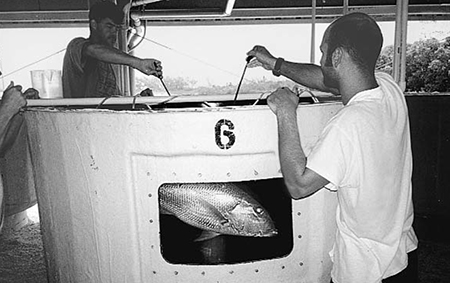
Prior to handling, fish should be fully anesthetized using 50 to 200 ppm dilution of 2-Phenoxyethanol. Different species have different reaction times to the anesthetic. Therefore, we recommend starting at the low end of the spectrum, waiting for results, and only moving up as needed to avoid overdosing. MS-222 (tricaine methanesulfonate) is also effective in sedating and anesthetizing marine brood fish, at dosages of 20 to 150 milligrams per liter. MS-222 is the only drug approved by the U.S. Food and Drug Administration for use with food fish in the United States, and it must have a withdrawal period of 21 days.
Transfer of the anesthetized fish from one tank to another is best done using thick plastic bags partially filled with water, or custom-made plastic stretchers. Sampling can be accomplished by inserting a hollow, 2 mm-diameter polyethylene canula approximately 10 cm into the genital opening of the fish and withdrawing the gametes through mouth suction. The urogenital opening in marine finfish is normally the posterior-most opening in the cloaca. Sperm or oocytes should be examined by microscope to determine the sex and stage of gonadal development of each fish.
All fish should also be measured and weighed to determine future dosages, treatments, and feeding rates. Finally, each fish should be marked using a unique, conspicuous external tag to facilitate future identification and record keeping on individual fish.
Prophylaxis and quarantine
Brood fish must be subjected to prophylactic treatment and acclimated to captivity before being stocked in maturation systems. Regardless of their condition, newly captured fish should be treated with antibiotics, by an intramuscular injection of 25 mg oxytetracycline per kg of body weight If external wounds persist during quarantine, oxytetracycline baths (check 50 ppm for three h for seven days) have proven successful with several species of marine finfish.
Most antibiotics are not FDA-approved for use with marine food fish in the United States. They can be used only for extra-label application under the supervision of a veterinarian or as part of an Aquaculture Investigational New Animal Drug (INAD) Exemption.
Parasite control

Potential ectoparasitic infestations normally found in the skin, gills, and bucco-pharyngeal area should also be treated during the quarantine period. A natural pepper extract commercially available in liquid form has been successfully used to induce detachment of ectoparasites through either a long-term treatment (Check 100 ppm for two h, every other day for a week) or a short-term bath (1,000 ppm or 1 ppt for a maximum of 15 minutes).
The short-term anti-parasitic treatment should be coupled with a mandatory freshwater bath of three to 15 minutes in dechlorinated water, which is the final step before stocking the brood fish in the quarantine tanks. Formalin baths (formaldehyde diluted at 37 percent, 100 ppm for three to10 min) have proven highly effective against skin and gill parasites of marine fish. They can be administered immediately prior to or after the freshwater baths.
Only those fish that have started feeding, are free of any parasite or disease, and have shown positive signs of acclimation to the captive environment (competitive feeding, relaxed swimming, and natural coloration patterns) should be stocked into the maturation tanks.
Long-term conditioning
Maturation tanks should be stocked with a 2:1 male to female ratio. Special attention should be placed on the diet, since it will ultimately have a direct effect on egg quality and, possibly, the fertility ratio and number of larvae produced.
It is advisable to provide the brood fish with a varied diet consisting of fresh frozen sardines, shrimp, squid and supplemental vitamin/mineral pellets or gels fed every other day to satiation. During the acclimation period, brood fish can spend up to two weeks without feeding. It may take as long as four weeks for some fish to begin eating in captivity, while others may begin feeding almost immediately.
Other considerations
Adding artificial substrates to the tanks to provide hiding spaces for stressed fish can reduce aggressiveness among the fish. Also, eliminating disturbances (noise, vibration, or light at night) around the broodstock maturation area is very important for minimizing stress, which can block the hormonal pathway that leads to gonadal maturation and ultimately spawning.
(Editor’s Note: This article was originally published in the December 2000 print edition of the Global Aquaculture Advocate.)
Now that you've reached the end of the article ...
… please consider supporting GSA’s mission to advance responsible seafood practices through education, advocacy and third-party assurances. The Advocate aims to document the evolution of responsible seafood practices and share the expansive knowledge of our vast network of contributors.
By becoming a Global Seafood Alliance member, you’re ensuring that all of the pre-competitive work we do through member benefits, resources and events can continue. Individual membership costs just $50 a year.
Not a GSA member? Join us.
Author
-
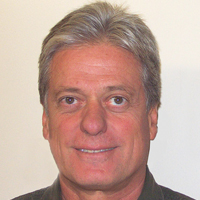
Daniel D. Benetti, Ph.D.
University of Miami
Rosenstiel School of Marine and Atmospheric Science
Division of Marine Affairs and Policy
4600 Rickenbacker Causeway
Miami, Florida 33149 USA
Tagged With
Related Posts

Health & Welfare
Advanced conditioning systems for marine fish broodstock
To be successfully conditioned to spawn in captivity, most marine fish species must be exposed to temperature and light cycles that mimic their seasonal changes in nature.
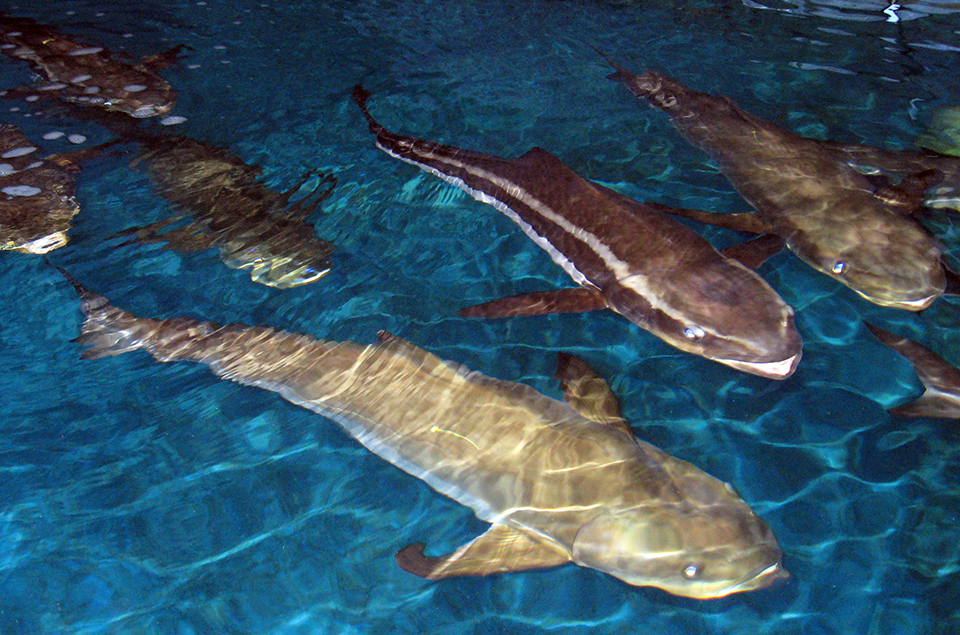
Health & Welfare
Cobia hatchery-to-market technology at UMEH
Cobia is a top emerging candidate for tropical and subtropical marine fish aquaculture. The University of Miami Experimental Hatchery has led ongoing research to advance the viability of raising hatchery-reared cobia.

Intelligence
Aquaculture of pelagic fish, part 1
Cage culture of yellowtail (Seriola quinqueradiata) in Japan is one of the most traditional and profitable aquaculture industries worldwide.
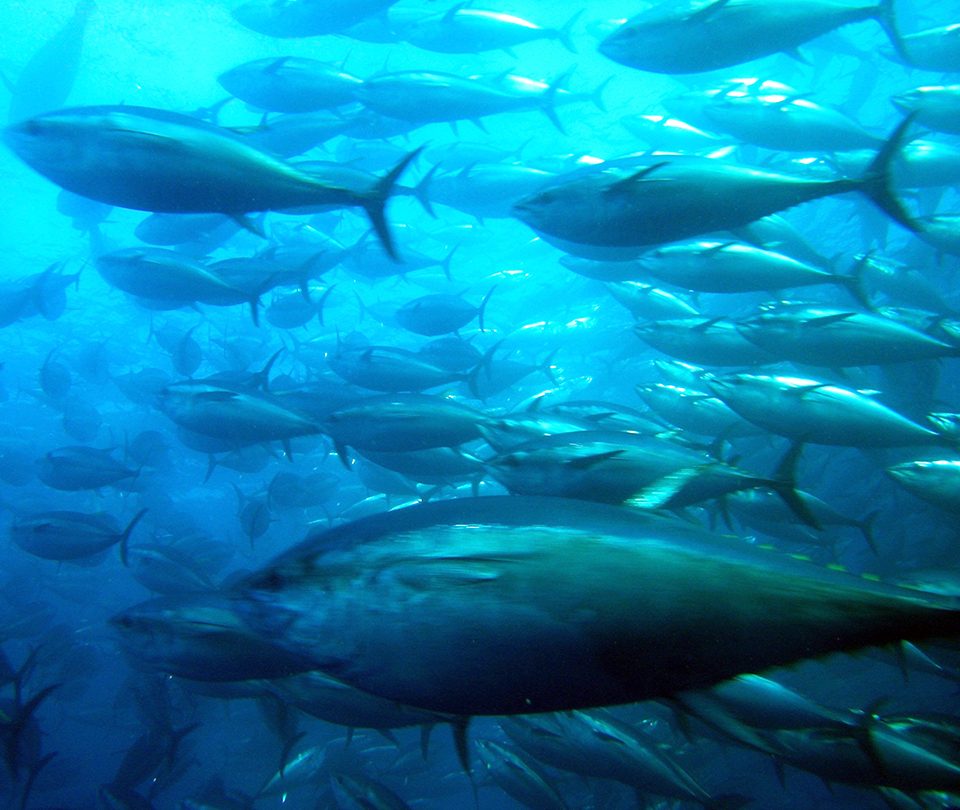
Intelligence
Public opinions pose barriers for tuna consumption
Safety and sustainability are key concepts affecting consumers’ decisions on tuna consumption. Although the benefits of consumption exceed the potential negative effects, tuna’s harmful attributes tend to negatively impact purchasing in at-risk groups.


